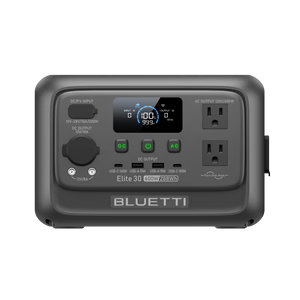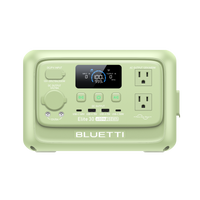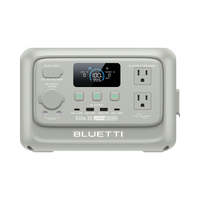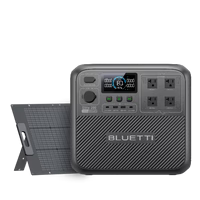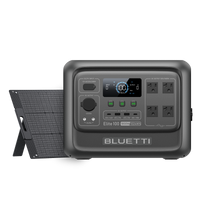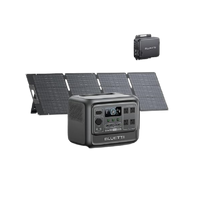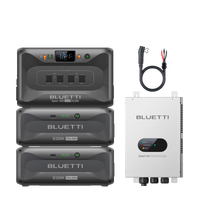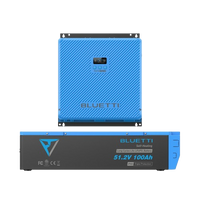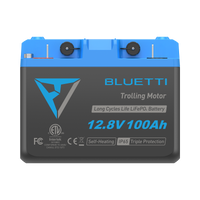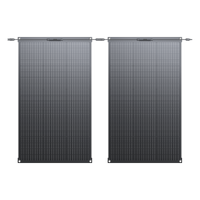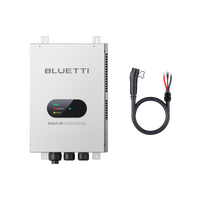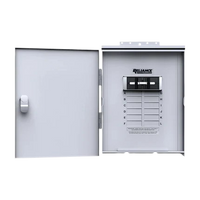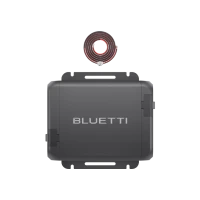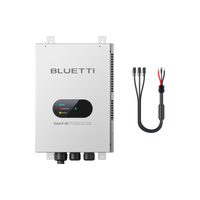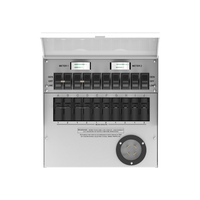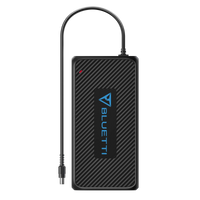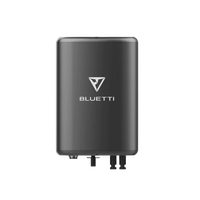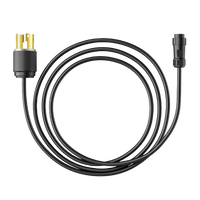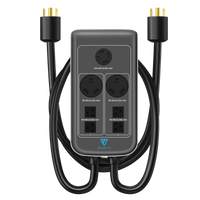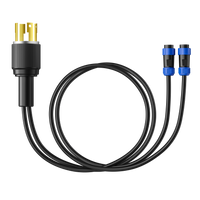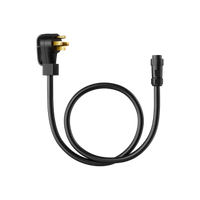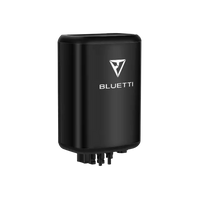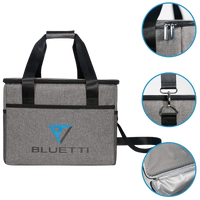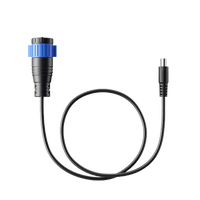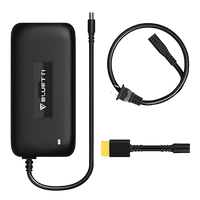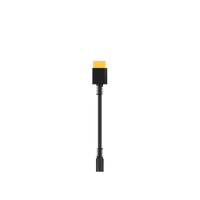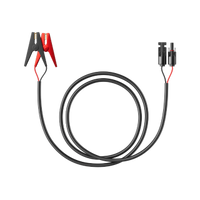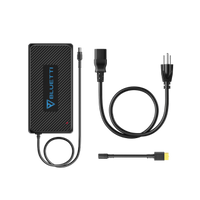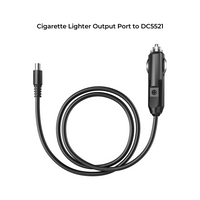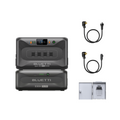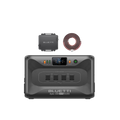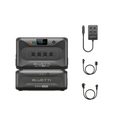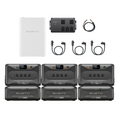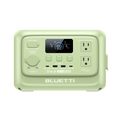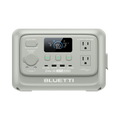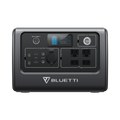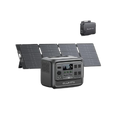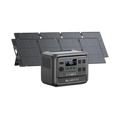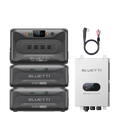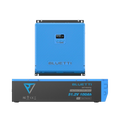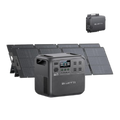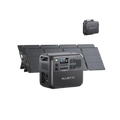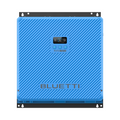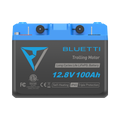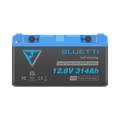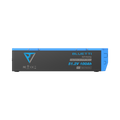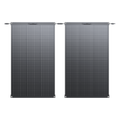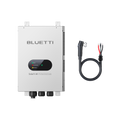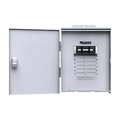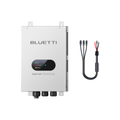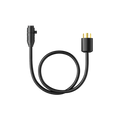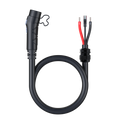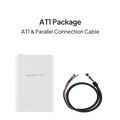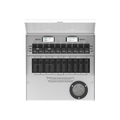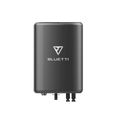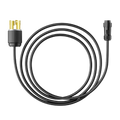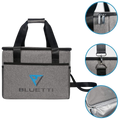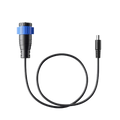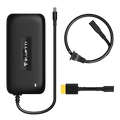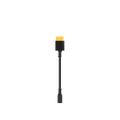Si vous dépendez de l'énergie solaire et souhaitez stocker l'électricité produite en heures creuses pour une utilisation ultérieure, une batterie vous permettra non seulement de le faire, mais aussi de bénéficier d'une véritable autonomie énergétique. Les panneaux solaires captent une énergie propre et abondante, mais seule la batterie vous offre cette liberté. Elle vous garantit un approvisionnement en lumière même en cas de coupure de courant.
Ce guide aborde l'importance des batteries solaires, décrit en détail les différents types de batteries et leurs prix, et fournit des conseils pour choisir la batterie adaptée. Nous passerons également en revue les trois meilleurs systèmes de batteries de secours. Si les capteurs solaires constituent un pas vers un développement durable, les cellules rechargeables permettent de libérer l'énergie stockée dans ces panneaux.
Articles connexes : En quoi les batteries solaires diffèrent-elles des batteries rechargeables ?
Meilleur système de batterie solaire de secours pour la maison au Canada en 2024
Les batteries solaires sont-elles rentables ?
La réponse dépend principalement de votre situation personnelle. Outre le coût supplémentaire que représente l'installation de batteries solaires, celles-ci présentent plusieurs avantages. Elles vous permettent d'éviter les pics de consommation d'énergie liés au kWh, de réduire les frais liés à la demande et de bénéficier d'une source d'énergie fiable en cas de coupure de courant.
Un autre avantage des batteries solaires est qu'elles permettent de disposer d'électricité même si votre fournisseur local ne propose pas le comptage net. En revanche, ce système n'est rentable que si le coût de la batterie est inférieur au prix de l'électricité consommée la nuit.
En définitive, les batteries solaires peuvent être considérées comme un investissement judicieux, car elles procurent souvent autonomie et avantages financiers, d'autant plus lorsqu'elles sont associées à différentes aides. Bien que les spécificités de chaque situation et les données de localisation soient essentielles à la prise de décision, il est toujours conseillé de considérer tous les aspects.
Que sont les batteries solaires ?

Les batteries solaires, généralement utilisées avec des panneaux solaires, sont des dispositifs de stockage d'énergie qui emmagasinent l'énergie électrique sous forme chimique pour une utilisation ultérieure et en cas d'urgence, lorsque les panneaux solaires ne produisent pas d'électricité. Elles peuvent stocker l'énergie provenant de n'importe quelle source, y compris le réseau électrique, qui est activé pendant les périodes de faible production solaire ou lorsque d'autres sources d'énergie renouvelables, comme l'éolien, sont disponibles.
Il existe différents types de batteries solaires. Chaque type possède sa propre composition chimique, ses avantages et ses inconvénients. Dans certaines situations, les batteries sont idéales pour stocker une grande quantité d'énergie pendant une courte période. Lorsqu'une alimentation stable est nécessaire sur de longues périodes, d'autres types de cellules sont plus adaptés. Parmi les options disponibles, on trouve les batteries au plomb, les batteries lithium-ion, les batteries redox à flux et les batteries nickel-cadmium.
Pour comparer les cellules photovoltaïques, il faut tenir compte à la fois de leur puissance nominale (en kilowatts) et de leur capacité de stockage (en kilowattheures). La puissance nominale indique la charge électrique totale que la batterie peut fournir à votre système, tandis que la capacité de stockage indique la quantité d'électricité qu'elle peut emmagasiner. Par exemple, une batterie solaire d'une puissance nominale de 5 kWh et d'une capacité de stockage de 10 kWh peut alimenter en continu une charge électrique allant jusqu'à 5 000 watts et satisfaire une charge de pointe de 5 kW pendant deux heures avant d'être déchargée. Si la batterie alimente une charge de 1 250 watts, elle peut fonctionner pendant au moins 8 heures avec une batterie pleine.
Combien coûtent les batteries solaires ?
Les propriétaires qui envisagent de passer à l'énergie solaire se concentrent généralement sur le coût des cellules photovoltaïques. En 2024, ce marché aura radicalement changé grâce aux progrès technologiques rapides et à la demande croissante d'énergies renouvelables.
Les batteries solaires sont disponibles dans différentes gammes de prix et avec diverses caractéristiques. L'option économique, composée de batteries au plomb-acide, coûte environ 120 CAD. Ces batteries reposent sur des technologies obsolètes qui nécessitent un entretien régulier, ce qui les rend beaucoup moins pratiques que les modèles plus récents.
Les batteries au plomb étanches (SLA) se situent dans le segment moyen de gamme, avec des prix allant de 300 à 550 CAD. Elles offrent à la fois disponibilité et rentabilité, principalement parce qu'elles durent plus longtemps et nécessitent moins d'entretien que les batteries au plomb concurrentes.
En tête de liste, on trouve les batteries lithium-ion, vendues à 1 850 $ CA l'unité. Ces batteries accélèrent le développement de la technologie solaire en offrant une fiabilité, une durabilité et une facilité d'utilisation accrues. Malgré leur coût initial plus élevé, leur longue durée de vie et leurs besoins d'entretien quasi nuls compensent largement cet inconvénient, ce qui en fait le choix privilégié des acheteurs.
Le prix des batteries solaires doit être évalué non seulement en fonction du coût initial, mais aussi de leur valeur à long terme. Des facteurs tels que leur durée de vie, les besoins d'entretien et leur compatibilité avec votre installation solaire sont des éléments clés pour déterminer le coût total de possession.
Aujourd'hui, le prix moyen d'une batterie domestique varie de 6 000 à 23 000 $ CA. Cette large gamme de prix reflète probablement des variations plus importantes en termes de capacité, de marque et de fonctionnalités supplémentaires, comme la connectivité intelligente et les onduleurs intégrés.
Types de batteries solaires
Il existe différentes variantes de batteries solaires, chacune présentant des caractéristiques distinctes. Les batteries au plomb sont économiques et fiables, mais nécessitent un entretien régulier.
Les batteries plomb-acide scellées, notamment les modèles AGM (Absorbent Glass Mat) et les batteries gel, nécessitent peu d'entretien et offrent une longue durée de vie. Les batteries AGM sont moins chères et fonctionnent bien par temps chaud comme par temps froid, tandis que les batteries gel, qui utilisent de la silice pour solidifier l'électrolyte, ont une durée de vie plus longue mais se rechargent plus lentement.
Les batteries lithium-ion, souvent appelées batteries lithium-fer-phosphate ou LiFePO4, représentent la technologie moderne des batteries solaires. Elles se caractérisent par des vitesses de charge et de décharge élevées, une longue durée de vie et une maintenance aisée. Bien que plus coûteuses, leur finesse et leur légèreté permettent de les intégrer dans des espaces restreints.
Comment choisir une batterie solaire
Choisir la bonne batterie solaire implique de prendre en compte plusieurs facteurs. La capacité de la batterie est primordiale : elle détermine la quantité d'énergie stockée et le nombre de batteries nécessaires. L'utilisation prévue, comme source d'énergie principale ou de secours, influence également ce choix. Si vous êtes raccordé au réseau électrique, renseignez-vous sur les aides fiscales et les crédits d'impôt disponibles.
La puissance/tension est cruciale pour déterminer sa compatibilité avec vos panneaux solaires et les autres composants de votre système. Un autre facteur essentiel est la profondeur de décharge (DoD), c'est-à-dire le pourcentage de charge maximal que vous pouvez atteindre avec votre batterie avant que ses performances ne soient altérées. Par ailleurs, le prix varie selon le type de batterie solaire. Une batterie au plomb est généralement moins chère, mais nécessite plus d'entretien. Les batteries au plomb étanches (SLA) constituent une option de milieu de gamme, tandis que les batteries lithium-ion, bien que plus onéreuses, sont les plus fiables.
Les 3 meilleurs systèmes de secours par batterie
Un système de batterie de secours adapté sera un facteur déterminant pour une production d'énergie solaire optimale.Parmi les innombrables systèmes disponibles, trois méritent d'être mis en avant pour leurs performances exceptionnelles et leurs fonctionnalités uniques. Poursuivez votre lecture pour découvrir plus de détails sur ces modèles haut de gamme.
Kit solaire AC500+B300S+PV350

Doté d'une puissance nominale de 5 000 W et d'une capacité de surtension de 10 000 W, il peut alimenter la quasi-totalité des appareils. La capacité de son bloc d'alimentation est extensible de 3 072 Wh à 18 432 Wh, vous assurant ainsi une alimentation continue, même en cas de coupures de courant prolongées.
L'ajout du panneau solaire PV350 d'une puissance de 350 W permet au système d'exploiter l'énergie solaire, contribuant ainsi au choix d'un produit écoénergétique et respectueux de l'environnement. Grâce à l'application dédiée, vous pouvez facilement contrôler et gérer le système. De ce fait, son utilisation est encore plus pratique grâce à toutes ses excellentes fonctionnalités.
Station d'alimentation extensible BLUETTI AC200MAX

Cet onduleur à onde sinusoïdale pure de 2 200 W offre une capacité de crête de 4 800 W. Sa capacité initiale de 2 048 Wh peut être étendue jusqu'à 8 192 Wh, permettant ainsi d'adapter le système aux variations de la demande énergétique.
Avec une puissance d'entrée solaire maximale de 900 W et une capacité de charge rapide double de 1 400 W, ce chargeur est ultra-rapide. Il constitue ainsi une source d'énergie fiable. L'application BLUETTI, grâce à son système intelligent, vous permet de gérer votre consommation d'énergie facilement et à moindre coût.
Kit solaire AC300+B300+3*PV350

C'est un excellent choix pour ceux qui souhaitent exploiter l'énergie solaire. Il est équipé d'un puissant onduleur de 3 000 W. De plus, sa capacité de surtension de 6 000 W permet d'alimenter une large gamme d'appareils. Le système est extensible jusqu'à 12 288 Wh. Grâce à ses trois panneaux solaires PV 350, il offre une puissance d'entrée solaire de 1 050 W, garantissant une recharge rapide et une autonomie totale par rapport au réseau électrique. Ce kit convient parfaitement aux personnes souhaitant optimiser leur production d'énergie solaire et assurer son fonctionnement en toutes circonstances.
Réflexions finales
En résumé, les batteries solaires sont la pierre angulaire d'un système d'énergie solaire. Elles jouent un rôle essentiel pour garantir l'indépendance énergétique et réaliser des économies, contribuant ainsi à un avenir durable. Le choix de la batterie dépend de plusieurs paramètres, tels que la capacité, la puissance, la profondeur de décharge et le coût. Parmi les systèmes disponibles, les kits solaires AC500+B300S+PV350, BLUETTI AC200MAX et AC300+B300+3*PV350 sont les plus fiables et offrent une capacité de stockage d'énergie élevée. Bien que l'investissement initial puisse paraître important, les avantages à long terme et les économies d'énergie potentielles font des batteries solaires un choix judicieux pour de nombreux propriétaires.






